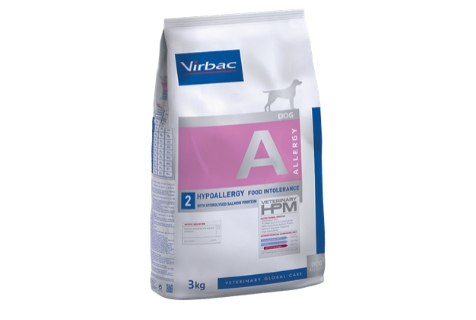Assessment of a new high protein – high essential fatty acid diet in dogs with chronic joint disorders

Overview
Fourty-eight dogs were analysed based on the scores of 7 mobility parameters (interaction with people, ability to rise to standing from lying down, ability to walk, lameness, ability to walk on stairs, ability to jump and ability to play). All parameters were significantly improved after 2 months of feed, compared to Day 0. Palatability and tolerance of this diet were good and 20% dogs even recovered an optimal weight despite no diet restriction.
Introduction
Osteoarthritis is a common painful degenerative and inflammatory disorder affecting joint and underlying bones 1 . It concerns 20 % of the canine population over 1 year-old and is essentially secondary to congenital or acquired musculoskeletal disorders2 . The multimodal management of the disease includes the use of NSAIDs, Disease Modifying OsteoArthritis drugs, Essential Fatty Acid enriched diets and physical therapy1 . The aim of this open study was to evaluate the effectiveness of a new dry dietetic pet food (VeterinaryTM HPM Joint & Mobility, Virbac, France) intended for the support of joint function in dogs.
1. Henrotin Y et al. Veterinary Journal, 2005; 170:113-123.
2. Comblain F et al. J Vet Pharmacol Ther. 2016; 39(1):1-15
Materials and Methods
Animals:
- 48 client-owned adult and senior dogs with mobility disorders for at least 3 months recruited and analysed
- For inclusion, at least 3 of the 7 mobility parameters had to be impaired
Diet:
- Tested diet (VeterinaryTM HPM Joint & Mobility, Virbac, France) for 2 months
- Metabolisable energy (ME) 373 kcal/100g dry matter (DM); protein 35% ME, fat 38% ME, carbohydrate 27% ME; omega-3 3.3% DM, EPA 0.7% DM
- no medical management allowed
Analysis and statistics:
- Seven mobility criteria: interaction with people, ability to rise to standing from lying down, ability to walk, lameness, ability to walk up and down stairs, ability to jump and ability to play, noted from 0 (normal) to 3 (serious alteration). Global severity score = sum of the scores of the 7 parameters.
- Assessments (questionnaires filled in by owners) on Day 0 (baseline) and every 2 weeks (W2, W4, W6, W8).
- Other parameters evaluated: body weight (BW), body condition score (BCS), kibbles palatability, digestive tolerance and owners’ satisfaction were also evaluated.
- For each criteria, pairwise adjusted (Dunnett) comparisons of time points were performed in the repeated measures ANOVA. The significant threshold was set to 5%.
Results:
Download the complete study to see the table of results
Conclusions:
Significant improvements of mobility and quality of life were observed in dogs fed the tested diet. An improvement of the body condition score was also observed in some dogs despite no restriction diet. These results may be attributed to the diet containing high levels of proteins for muscle maintenance and omega-3 fatty acids known to reduce inflammation and pain. The good tolerance and palatability of this diet should allow an optimal compliance over a long time period. A controlled study is now required to confirm these results and an evaluation over a longer period would also be interesting.
5th Animal Health and Veterinary Medicine Congress, Valencia, Spain, 2016


